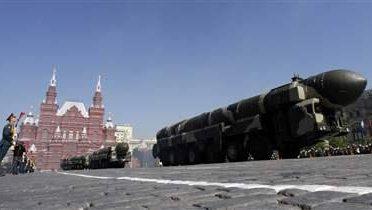Editor’s note: This is the nineteeth chapter from the book Tactical Nuclear Weapons and NATO, edited by Tom Nichols, Douglas Stuart and Jeffrey D. McCausland and published by the Strategic Studies Institute of the U.S. Army War College .
ABSTRACT—
Arms control agreements negotiated between Washington and Moscow over the past 50 years have focused on strategic offensive nuclear arms. Aside from the 1987 treaty banning intermediate-range nuclear force (INF) missiles and related unilateral steps, non-strategic nuclear weapons (NSNWs) have remained outside the arms limitation efforts. Following conclusion of the New Strategic Arms Reduction Treaty (New START) in April 2010, however, President Barack Obama called for including NSNWs in the next round of negotiations. This chapter provides background on NSNWs, reviews U.S. and Russian views on limiting such weapons, and outlines options for dealing with them in arms control arrangements. These options include confidence-building measures, unilateral steps, and negotiated legally binding limits.
The New START Treaty, which entered into force in February 2011, requires that the United States and Russia reduce their strategic offensive forces so that no later than February 2018, each has no more than 700 deployed strategic delivery vehicles—that is, intercontinental ballistic missiles (ICBMs), submarine-launched ballistic missiles (SLBMs), and nuclear-capable heavy bombers; no more than 800 deployed and nondeployed ICBM and SLBM launchers and nuclear-capable heavy bombers; and no more than 1,550 deployed strategic warheads. The INF Treaty eliminated all ground-launched missiles and launchers for missiles with ranges between 500 and 5,500 kilometers.
The term “non-strategic nuclear weapon” is used here to include nuclear warheads for all delivery systems not limited to New START or banned by the INF Treaty. This category of nuclear warheads includes gravity bombs for aircraft other than nuclear-capable heavy bombers, nuclear warheads for naval cruise missiles and torpedoes, and nuclear warheads for anti-ballistic missile (ABM) and air defense systems. The NSNWs term would also capture any nuclear warheads for surface-to-surface missiles with ranges less than 500 kilometers and nuclear artillery shells, should such weapons remain in the arsenals. NSNWs are also referred to as tactical or sub-strategic nuclear weapons.
As a result of its 2010 Nuclear Posture Review (NPR), the U.S. Department of Defense announced that it would retire and place in the dismantled queue the nuclear warheads for its sea-launched cruise missiles. This leaves the U.S. non-strategic nuclear arsenal consisting solely of B-61 gravity bombs. The Russians maintain a larger and more diverse non-strategic nuclear inventory, including gravity bombs plus nuclear warheads for torpedoes, sea-launched cruise missiles, ABM, and air defense systems, and possibly other kinds, totaling as many as 3,700-5,400 warheads. Many of those may be old and nearing retirement; the “nominal’ load of Russian non-strategic nuclear delivery vehicles is believed to be around 2,100 warheads.



